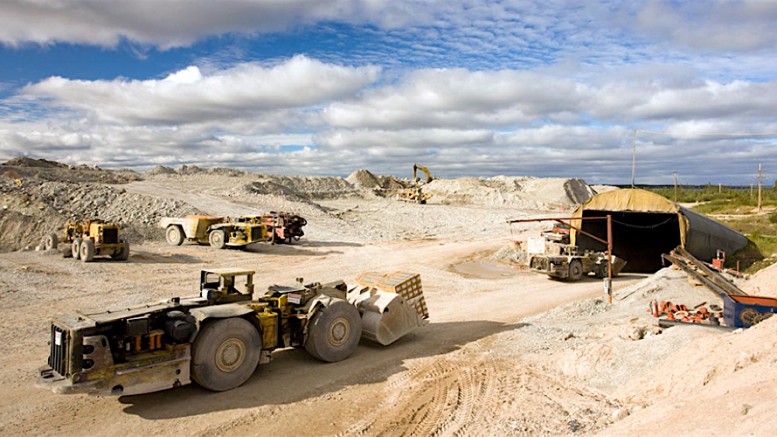With its Cigar Lake uranium mine in northern Saskatchewan on care and maintenance for the majority of the second and third quarters, Cameco (TSX: CCO; NYSE: CCJ) reported a quarterly net loss of $61 million ($78 million adjusted) for the third quarter, following a net loss of $53 million in the previous quarter.
Cigar Lake restarted in September, after a six-month suspension in response to the Covid-19 pandemic.
Cameco’s president and chief executive Tim Gitzel noted in a press release that the safety of employees and communities have been a top priority in the company’s actions this year.
“As expected, our results continue to be impacted by the proactive operational decisions taken earlier this year,” Gitzel said. “We believe that the actions we have taken to slow the spread of the Covid-19 virus are prudent and reflect our values – placing priority on the health and safety of our employees, their families and their communities. However, our decisions do come with near-term costs.”
For the quarter, Cameco reported revenue of $379 million, compared to $303 in the same quarter of last year. The company sold 6.7 million lb. uranium oxide at an average realized price of US$33.77 per pound.
Cameco’s share of production from Cigar Lake in the recent quarter was 200,000 pounds. (Cameco is the operator and holds 50% of the mine with partners Areva, Idemitsu Uranium, and TEPCO Resources.)
The uranium miner expects its share of production for the year to be around 5.3 million lb. uranium oxide.
Adding uncertainty for the company is a tax dispute with the Canada Revenue Agency. On Oct. 30, Cameco reported CRA is appealing a June Federal Court of Appeal decision that ruled in the miner’s favour regarding its dispute of reassessments issued for 2003, 2005 and 2006. If the Supreme Court decides to hear the CRA’s appeal, it could be heard in the second half of 2022.
While 2020 has been a tough year, Gitzel expressed optimism for the future.
“In an environment where we think trade policy, like the amendment to the Russian Suspension Agreement in the U.S., will create opportunities for commercial suppliers like Cameco and where utilities have growing uncovered requirements, we are excited about the fundamentals for our industry,” he said. “We see demand for nuclear growing driven by an increasing focus on electrification and the recognition that to achieve this while still meeting clean-air and climate change goals, nuclear will be needed in the toolbox. And this is occurring precisely while there is growing uncertainty and risk around global uranium supply.”
Gitzel added the company believes rising concern around security of supply will allow it to “layer in the long-term contracts necessary” to support the restart of its McArthur River/Key Lake operations in Saskatchewan.
Cameco’s McArthur River-Key Lake and Rabbit Lake mining operations in Saskatchewan were suspended prior to the pandemic and remain on care and maintenance.
It also holds a 40% interest in the Inkai in-situ recovery mine in Kazakhstan with 60% held by Kazatomprom. The operation was on reduced production between April and August. Given uncertainty in Kazakhstan caused by the pandemic, Cameco says it will not be providing an outlook of its expected purchases of Inkai production this year. (The company is entitled to buy 59.4% of production at a discount to the spot price.)
Cameco recently strengthened its balance sheet, and at the end of September, it had $793 million in cash and short-term investments and $1 billion in long-term debt. Another $1-billion credit facility remains undrawn.
For 2020, Cameco announced it will issue an annual dividend of 8¢ per share.
Alexander Pearce of BMO Capital Markets weighed in on the results.
“Cameco’s Q3/20 results were unlikely to be straightforward, given the restart of Cigar Lake mine late in the quarter and withdrawn guidance,” he stated in a research note. “However, despite solid sales, the company reported a sizeable miss on earnings, largely on higher-than-expected cost of sales, presumably due to greater-than-expected purchase volumes and restart costs. Whilst some of this may unwind in Q4/20, we would expect a modestly negative impact to our full-year estimates at this stage.”
On a positive note, Pearce noted that, “whilst a tough quarter overall for Cameco in Q3, it remains well placed to benefit from our expectations of improving market conditions for uranium into 2021 and beyond.”
Pearce has a target price on the stock of $17 per share.
At press time in Toronto, Cameco was trading at $11.98 per share within a 52-week trading range of $7.69 and $16.71.
The company has about 396 million common shares outstanding for a market cap of about $4.7 billion.
— This article first appeared in the Canadian Mining Journal, part of Glacier Resource Innovation Group.


Be the first to comment on "Cameco reports $61M loss in Q3"